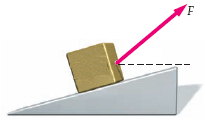Daniel B. answered • 02/24/21
A retired computer professional to teach math, physics
Let
m = 19.8 kg be the mass of the box,
α = 16.3° be the angle of the ramp,
β = 42.8° be the angle of the force,
g = 9.81 m/s² be gravitational acceleration.
The weight of the box, mg, can be decomposed into the sum of two forces:
mg = Gn + Gp
where, the "+" denotes vector addition, and
Gn = mgcos(α) is the force normal to the surface of the ramp, and
Gp = mgsin(α) is the force parallel to the surface of the ramp.
The force Gn would cause friction if there were any, but in this problem we are to ignore that.
The force Gp is the force pulling the box down the ramp and that is the force the mover
must overcome.
Similarly, the mover's force F can be decomposed
F = Fn + Fp
where, the "+" denotes vector addition, and
Fn = Fsin(β-α) is the force normal to the surface of the ramp, and
Fp = Fcos(β-α) is the force parallel to the surface of the ramp.
Just to overcome the downward force of gravity, the mover's force must satisfy
Fcos(β-α) = mgsin(α)
F = mgsin(α)/cos(β-α)
Substituting actual numbers
F = 19.8 × 9.81 × sin(16.3°) / cos(42.8° - 16.3°) = 60.9 N






